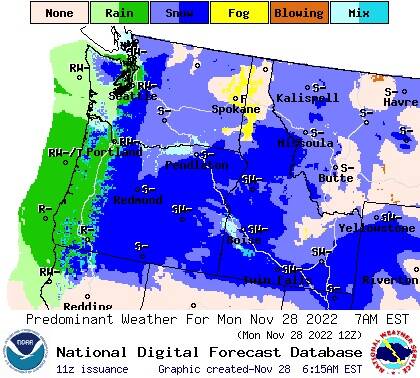Grays Harbor could see snow this week, starting Tuesday morning, for the first time this season.
A cool, precipitous air mass is headed for the Pacific Northwest, but whether or not it will deliver snow to the Harbor — and how much — depends on exactly when it will reach the coast, according to Jeff Michalski, a meteorologist with the National Weather Service in Seattle.
Rain and snow showers will arrive mostly after 10 a.m., according to a weather service forecast.
“We have a funnel system moving in on Tuesday,” Michalski said. “Initially, it will be cool enough that the precipitation will be falling as snow, but as the day progresses on Tuesday, there will be a transition over to rain. The timing of that air mass moving in will affect the total snow amounts.”
With daytime highs in the mid-40s, afternoon precipitation will likely be in the form of rain, Michalski said, but cooler nighttime temperatures — lows hovering around freezing — will deliver “a borderline rain and snow mix.”
Chances of precipitation for each of the next three days are high — from 70% to 100% — but snowfall is less certain. Michalski said the Washington coast from Forks to Grays Harbor has a 20% chance to receive at least one inch of snow on Tuesday, Wednesday and Thursday, respectively. The chances of the same area receiving more than two inches of snow are only 10%.
Rain is still forecast for the rest of the week following Thursday, but at a lesser quantity and likelihood.
For the third year in a row, meteorologists are predicting a La Niña event in the Western United States this winter, meaning conditions, on average, will be cooler and wetter.
November and December are usually two of the season’s three wettest months, according to historical data from Bowerman Airport. With the exception of an early November storm that pounded Western Washington with three to five inches of rain, this month has been relatively dry, with under two inches of rain falling in the last week.
While the Harbor’s snowfall will likely be limited, if present at all, Michalski said both the Olympic and Cascade mountains should receive heavy snowfall.


